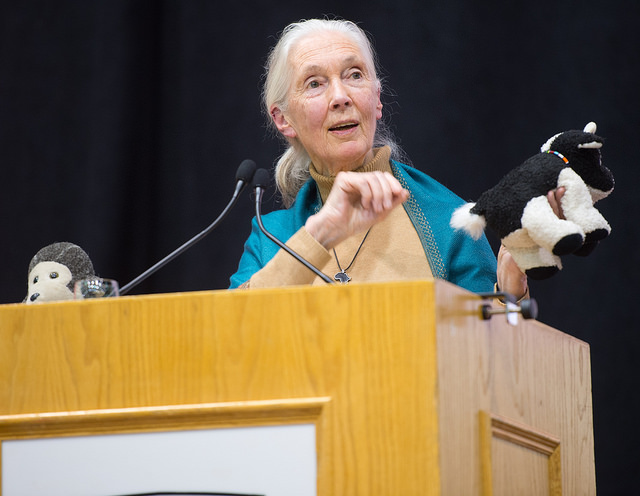聯合國和平大使兼動物福利倡議者、英國科學家珍·古德(Dame Jane Goodall)總是帶著一隻乳牛娃娃巡迴演講,用這隻乳牛娃娃解釋甲烷和全球暖化的關係。
上週結束的氣候大會(COP21)針對全球六種溫室氣體的排放定訂出具法律約束力的全球性協議,其中一種溫室氣體就是甲烷。不過在兩週以來的會議中,畜牧業和甲烷對全球暖化的影響只在國際人道協會(Humane Society International)贊助的邊會上被提起過一次。
聯合國和平大使兼動物福利倡議者、英國科學家珍·古德(Dame Jane Goodall)女士。圖片來源:University of Winnipeg(CC BY-NC-ND 2.0)。
全球氣候協議 未重視肉食影響暖化
COP21期間,珍古德和動物福利國際基金總裁兼執行長Azzedine Downes在會後活動上討論動物與全球暖化議題並回答問題。
他們對於全世界尚未正視肉食增加的氣候後果感到訝異,但也抱持希望。
甲烷是動物消化過程中和糞便儲存時產生的氣體。根據聯合國糧農組織的資料,全球畜牧業排放的甲烷是每年7.1億噸二氧化碳當量,佔全球人為溫室氣體排放量的14.5%。
歐盟畜牧業甲烷排放量佔總溫室氣體排放的12.8%,美國佔10%;歐盟每年生產83億隻的食用動物,美國則是100億隻。
全球畜牧業碳排放 比交通運輸還高
長期倡議環境和動物福利的德國歐洲議會議員萊恩(Jo Leinen)在國際人道協會邊會上指出,畜牧業往往傷害動物、人類和地球的健康。
據萊恩估計,每年有760億動物被畜養和宰殺,製成食品。「肉類對溫室氣體排放的貢獻比全球交通運輸還高。」
「全球人口現在70億,未來將成長至100億,每個人都這樣吃肉,我們也不用討論氣候變遷了。」萊恩警告。
畜牧業另一個不利環境之處是水資源的用量。每一種食物都有其「水足跡」,也就是每磅食物生產時所需的水量加崙數。每磅牛排的水足跡起碼1800加崙。
在這場COP21邊會上,畜牧業和動物福利專家所要傳達的訊息相當清楚:「少肉食,少暖化」可創造環境、人類和動物三贏。
中國畜牧業不人道 歐洲議會將率先關切
先不談動物福利,生產肉品消耗的水量和甲烷的暖化效果只是畜牧業損害環境的前菜,土地劣化、水污染和空氣污染還在後頭。
國際人道協會致力喚起政治界、科學界、醫學界和消費者族群對此議題的重視,盼能讓畜牧業在氣候協議中佔有一席之地。
此外,萊恩也以歐洲議會中國關係代表身分,關切中國畜牧業的不人道與健康問題。萊恩表示,「現在開始,動物福利將會列入歐洲議會和中國對話的議程中。」
農場動物沒能在2015巴黎氣候協議中出現。但是倡議人士承諾畜牧業議程將會繼續留在巴黎大會之後的對話中。
Dame Jane Goodall travels the globe 300+ days each year – with a cow – a small black and white stuffed toy. The British scientist and UN Messenger of Peace is also an animal activist.
Cow also helps Goodall explain to the world the relationship between methane gas (CH4) and global warming.
During the 2015 United Nations climate change talks, COP21, Dame Goodall and Azzedine Downes, president and CEO of the International Fund for Animal Welfare, came to Paris to discuss animals and global warming. The two talked conservation and answered questions during an after-hours event at the Paris Museum of Science and Industry.
Both Goodall and Downes, renowned animal conservation thought leaders, are amazed that the world is not yet willing to seriously consider the climate consequences of the world’s ever-increasing appetite for meat. Yet they have hope.
COP21 is the 21st meeting of the 196 Parties to the United Nations Framework Convention on Climate Change, UNFCCC. During the two-week meeting, which opened November 30, government delegates have been negotiating the text of a new universal, legally-binding climate agreement to limit emissions of six greenhouse gases.
One of those greenhouse gases is methane.
Yet, animal agribusiness and the impact of methane emissions on global warming was mentioned only once in the COP21 venue here in Paris, when the Humane Society International sponsored a side event open to all.
Methane is produced during an animal’s digestive process and when animal manure is stored in holding areas.
Total methane emissions from global livestock as reported by the UN’s Food and Agricultural Organization “is 7.1 gigatonnes of CO2-equivalent per year.” This “represents 14.5 percent of all anthropogenic GHG emissions.”
Methane emissions from animal agriculture are 12.8 percent of the EU’s total greenhouse gas (GHG) emissions and 10 percent of U.S. total GHG emissions.
The EU produces 8.3 billion animals annually for food, while the United States raises more than 10 billion animals annually for food.
Jo Leinen, a Member of the European Parliament representing Germany, was on the Humane Society International panel for the group’s event. He has long been a champion for both the environment and animal welfare. He decries the fact that animal agriculture usually hurts animals, human health, and the planet.
MEP Leinen estimates that 76 billion animals are raised and killed around the globe each year for food production. “Meat contributes more to GHG emissions then worldwide traffic,” he says.
“With a world of seven billion [people], and tomorrow 10 billion, if everyone eats meat like this we can forget about climate,” Leinen warned.
Water utilization is another harm to the planet resulting from animal agriculture. The foods that we eat each have a “water footprint” – the number of gallons of water required to produce a pound of food. At least 1,800 gallons of water are used to produce one pound of beef steak.
Putting animal cruelty aside, the amount of water used to produce meat and the impact of methane on global warming are only the beginning of meat production’s environmental harms. In addition, the Earth is scarred by land degradation, water pollution, and air pollution.
Humane Society International is raising awareness in politicians, scientists, physicians and consumers. The organization is working to get animal agribusiness a landing place in multilateral agreements.
MEP Leinen is already taking action in his capacity as President of the European Parliament’s delegation for relations with China.
Concerned about cruel and unhealthy animal production in China, he recently announced change, saying, “From now on, the issue of animal welfare will be on the agenda in future talks between EU MEPs and their Chinese counterparts.”
The message delivered by the handful of experts discussing animal agriculture and animal welfare on the sidelines of COP21 is clear. “Less meat, less heat” helps the environment, humans, and animals.
Farm animals will not be mentioned in the 2015 Paris Agreement. But, advocates promise that agribusiness will be on the agenda of the post-Paris cycle.
※ 全文及圖片詳見:ENS









